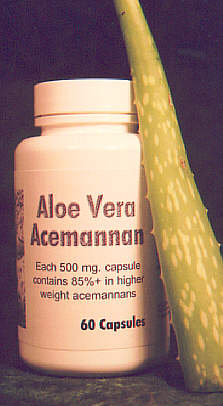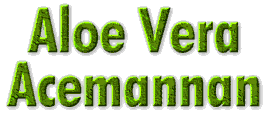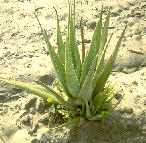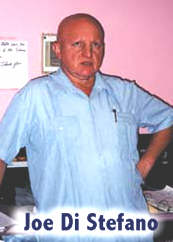

 The powerful immune-response
The powerful immune-response
effects of a group of poly-
saccharides ("aloe polymannans")
has created an avalanche of
research, a large American MLM
company that sells off the less
effective, lower weight variety at
hefty markups, and an injectable
version in Florida that produced so
many cancer remissions that medical
authorities had the clinic closed
down.
 Now we're here to
Now we're here to
tell "the rest of the story."

 ost people are aware of the beneficial effects of
aloe vera -- in soothing burns topically, aiding digestion, etc.
Few are aware of modern discoveries concerning one powerful
group of polysaccharides called "polymannans."
 Mannans are the mortar
that hold the building blocks of the immune system together, aiding
macrophages and other components of immune response to
"recognize" invasive agents. Without these complex
glyconutrients, the immune system operates blindly --
something akin to driving a car while blindfolded.
Stripped of their ability to recognize pathogenic
bacteria, viruses, molds, and other micro-organisms,
your own cells will allow these invaders to operate and reproduce
freely, creating an internal environment that set the
stage for a host of disease conditions. (The documents
assembled with links below provide considerable depth
for those who want to know what we've managed to
uncover over the last 20 years.)
Enter Mannatech
 Most of the crucial
pioneering research in this area was conducted by
Carrington Laboratories of Irving, Texas. One
reliable source has told us that Carrington has
spent well over $50 million (though larger numbers
are out there) in research on the medicinal
effects of various glyconutrient fractions of
the aloe plant. To date, the largest outlet for
Carrington's products has been an MLM (multi-level
marketing) company in the U.S. called
Mannatech
Incorporated. We cannot think of a single
disease that, at some point, one of the legends of
Mannatech distributors out there has not called or emailed
us about -- saying that
a
Mannatech product was the definitive cure.
 Do not fault Mannatech.
(Our experience with network marketing and pyramid schemes, in general,
is that if they care health care products, expect to see a
strong propensity for curative exaggerations in the field --
a fact frequently cited by any of a number of state attorney
general offices in the U.S. tasked with consumer protection.
And then there are the outrageous markups necessary to sustain
opulent marketing plans rich enough to attract an effective sales force...
but that's another article.)
This is not the same as saying that
many of the beneficial claims of those consumable products
with lower chain mannans are not substantive -- (though any
claim of exclusivity most decidedly is). We wouldn't
have investigated this thoroughly if the science behind this
emerging field of nutrition (one of relatively recent
development) was not solid.
 However, like all
facets of the nutraceutical world, this is an instance where
the devil is in the details. Most of the products made
in the world of aloe extracts involve either spray
drying or freeze drying. A gentler method that would
ensure that more of the long and "extra long" acemannans
are left intact, thereby avoiding heat lability issues,
would be low temperature dehydration. The problem
is expense if you're trying to produce a cheap product
for the network marketing industry. Since we don't have
this burden, we opted to work with colleagues of Dr. Siegel,
which makes it this way.
Aloe Vera Acemannan
 In addition to low temperature
dehydration, Aloe Vera Acemannan is guaranteed to contain
at least 85% polymannans, with not less than 25 to 35% the extra
long chain acemannans, the
premium aloe polymannan nutrients. It is extracted from
aloe barbadensis miller, the aloe plant shown to
have one of the highest levels of polymannan content.
The only ingredient in this product is aloe vera gel powder,
200:1. (For an alternative protocol to bypassing
the "first pass" phenomenon and getting as much as possible
from this product, see the inset statement at the bottom
of the right column. Also, for those who many have read about
1,000:1 or other riduculous extraction claims, read
our customer response).
 If you have any questions
about this premium product, please email us.
Important Links
- What is Aloe? --
This Word file provides an overview of the nutritional components of
aloe vera, with special emphasis on aloe polymannans -- broken down
into short chain, medium chain, large chain, and very large
chain. Discusses what polymannans do in the body and why
these nutrients have been disappearing from our diet in the
industrial age.
- Aloe's Growing
Acceptance -- A short, three page Word file that discusses
the increased acceptance of aloe vera, particularly on account
of our better understanding of the effects of polymannans.
These include immunomodulation effects and the anti-viral
effects of acemannans -- with mention of the inhibition
of HIV infection of lymphoblasts and the selective
binding of HIV infected cells.
- U.S. Patent No.
5,786,342 -- A clear leader in the research of mannans is
Carrington Laboratories of Irving, Texas. (They have been
the principal supplier to Mannatech, a popular multi-level
marketing company in the U.S.) This patent, filed in June, 1995,
and issued in July, 1998, discusses the known medicinal effects of
acemannans in its corpus.
- Effects of
aloe vera preparations on the human bioavailability of Vitamins C
and E. This study, conducted
at the University of Scranton (Scranton, Pennsylvania, USA),
demonstrates how the inner gel fraction of the whole leaf (which would contain
acemannans) effected a substantial increase in the bioavailability
of vitamins A and C in the subjects tested. Be sure to view
the tables at the end of this four page paper.
- Compliments
Using Mannose -- This interesting graphic shows how
protein enzymes in the blood called Compliments orchestrate
immune system responses. Compliments coat invasive agents
with mannose containing molecules so phagocytes can engulf
them.
- Aloe, Immunity,
and Health Care -- This is the third page of the July, 2001 issue of
"Inside Aloe," put out by International Aloe Science Council, Inc.
Of particular value is the content, expressed in clear layman's
terms, of the value of mannan glycoproteins (GP), which help
the body identify "nearly all dangerous micro organisms,"
and the nature of their signal structure.
- The biological
activities of mannans and related complex carbohydrates (Doc, 9 pages)
-- This study
was conducted at Texas A & M University and probably funded by
Carrington Laboratories. The study's abstract says it all:
"Complex polymers containing mannose (mannans) possess significant biological activity
when administered to mammals. When given orally, they inhibit cholesterol absorption
and induce hypocholesterolemia. If administered by other routes, they bind to
mannose-binding proteins and induce macrophage activation and interleukin-l release,
inhibit viral replication, stimulate bone marrow activity, promote' wound healing,
and inhibit tumor growth. This range of activities makes the mannans potentially
important biological-response modifiers and therapeutic agents."
- The
Importance of Harvesting and Manufacturing Premier Aloe Vera -- This document
like many of the links on this page were provided by colleagues and associates of
Dr. R. Siegel, M.D., one of the foremost authorities on aloe research and the
medicinal properties of its diverse nutrients.
The dehydrate powder sited in this document is what you are
purchasing from Alpha Omega Labs.
- Aloe:
The Source of Master Glyconutrient -- Dr.
H. Reginald McDaniel (M.D.), like Dr. R. Siegel, is another pioneer in the field
of aloe glyconutrients. This paper is a technical read, but it contains
a level of depth on the importance of mannans in human physiology not
contained in other documents. Despite being only slightly over a page
in length,
it gives both a chronological overview of what has happened since
initial discoveries were made in the mid-80's through accepted
principles now in vogue in the early 21st century. Among its
elucidating points: (1) "Cell relationships from attraction of the sperm
to the egg, embryological growth development and differentiation, cell adhesion,
defense, healing, and programmed cell death with regeneration (apoptosis),
is regulated by a sugar-coding domain in activator molecules."
(2) "The medical and scientific community is now rapidly accepting the power
of dietary sugars low or absent in the modern diet, to support restoration
of health." (3) As always, the corrupt influence of the pharmaceutical
industry to short-circuit advances in this field and the dissemination
of both product and the knowledge behind it. On this same
line of thinking is a two-page overview by Dr. R. Siegel
on The
Science of Immunity and The Regulation of Immunity.
- Natural
Plant Molecules -- Mannans are critical to immuno-function. This
five-page paper, with ample footnoted references, provides technical
descriptions of their mechanisms of action. A good primer on the
subject for those who will appreciate the technical detail.
- Innate
Immune Mechanisms: Non-Self Recognition -- Abstract:
"The innate immune system contains a range of cell-bound and soluble proteins
which eliminate pathogens by recognizing unique molecular patterns expressed
by microorganisms, but not by host cells. Alternatively, host cells express
proteins that protect them from attack by the alternative pathway of complement
activation whereas foreign organisms lack these protective proteins and are,
therefore, susceptible to complement attack." This twelve page,
1999 paper was written
by Christopher R. Parish with Australian National University and is a good
primer on the critical importance of recognition molecules.
- Carbohydrate
Research Headlines -- This is a good four-page summary of findings
up to the 2001-2002 time frame; however, the contents are largely covered
in other links above. Check out the graphic on inflammatory protein
disposal and the role of mannans in the process on page two.
- Inside
A White Blood Cell -- Excellent graphic demonstrating the
the effects of mannan deficiency and the mechanics behind mannose
assistance in producing the right enzymes necessary for the immune
system's white blood cells to do their assigned job.
Instructions
 Take one to two capsules per day.
A method for taking this product that we feel is optimal is described in the
right column.
Español,
Português,
Deutsch
 Italiano,
Français,
Norsk
Italiano,
Français,
Norsk
|
 To U.S. Users: To U.S. Users: This
product has not been evaluated by the U.S. Food & Drug Administration,
nor has any of the contents of this page.
This product is, therefore,
not intended to diagnose, treat, cure, or prevent any disease.
|
Albarin: Cancer
Cure or Hoax?
 The long chain acemannans in
our Aloe Vera Acemannan are undoubtedly central to a banned,
intravenously administered aloe extract product in the U.S.
called Albarin -- made using a special freeze dried
process developed by Ivan Danhof, M.D., and celebrated
among alternative cancer therapy proponents.

 On October 11, 2001,
120 agents
of the U.S. Food & Drug Administration, Florida Department of
Law Enforcement, and Hillsborough County Sheriff's Office conducted
raids on Florida clinics using Albarin -- clinics run by
nutritionist, Joe di Stefano.
(See video: Cancer
and Albarin: Alternative Treatment? (11/28/01).)
This event is now a cause celebre, widely reported by
alternative health care and civil liberty organizations, ranging from
Life
Extension and American Freedom Press. Incidentally,
despite the fact that the FDA could not find fault sufficient to
file charges, that
didn't stop money-hungry plaintiffs' attorneys from putting out the
word that
they were looking
for potential clients.
 The reports of strong anti-viral
and anti-cancer properties of Albarin dovetail with our
understanding of its mechanisms of action. (See
hepatitis-C with
anti-cancer abilities.)
 Does Albarin cure
cancer? If you ask the hundreds of users who have had been
successfully treated, they will tell you, "Absolutely." Without
access to patient records, we will tell you that we simply
do not know -- (although it has been reported that the first
100 patients Danhof used Albarin on came from a hospice,
where they had been told they only had two to three months
to live -- and 94 of these patients were saved, a remarkable
success rate for terminal cancer patients.)
 What we WILL tell you is
that the suppression of Albarin fits
the very same pattern we've seen with
cancerolytic herbs, underscoring the
motivations that prevent the cancer industry
from allowing any real, effective treatment to be made
public. (Keep in mind that Florida oncologists felt
very threatened. After all, Albarin treatment at
The Medical Center for Preventative and Nutritional Medicine
was running just $1,100 for the complete program, from initial
visit to remission -- about 25 treatments.
This is equal to about one week's worth of chemotherapy.
How could the cancer industry afford to let this success
get out of the bag and damage oncologists' income?)
 What we will ALSO tell you
if that if you read the research behind polymannans (see links at bottom
of left column), we believe
you will be able to connect the dots for yourself -- as we have.
 And this is infinitely
better than allowing the political powers that be to connect
the dots for you.
|
Getting Around
"First Pass" ...
Then "Die-Off"
 First of all, if you do not
understand the principle of "first pass," please read our introduction
in the natural suppository section.
 To get the most out of this
product, we recommend that you take two capsules and break each of
them open, spilling the contents into a small cup. Then use a small
spoon to mix this powder with one Tsp. (15 ml.) of water or your
favorite juice.
 Instead of immediately
swallowing the mix, which at this point will have a somewhat
light, gel-like consistency, drink it and hold it under your
tongue (sublingually) for about one minute before swallowing.
 The taste of
Aloe Vera Acemannan is somewhat "herby" and slightly bitter,
but with the flavor of the juice, it is well masked. Promise.
 Last of all: Last of all: Users of this
product often note a mild headache and/or slight nausea after
initially using this product. This "die-off" effect, known for its
flu-like symptoms, is the body's
response to an overload of dying pathogenic micro-organisms created
by a newly alerted immune system. The symptoms soon pass.
|
|


 'Similar product' correspondence
'Similar product' correspondence
 ost people are aware of the beneficial effects of
aloe vera -- in soothing burns topically, aiding digestion, etc.
Few are aware of modern discoveries concerning one powerful
group of polysaccharides called "polymannans."
ost people are aware of the beneficial effects of
aloe vera -- in soothing burns topically, aiding digestion, etc.
Few are aware of modern discoveries concerning one powerful
group of polysaccharides called "polymannans."